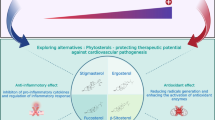Abstract
Preincubation of hepatoma cells and human skin fibroblasts in the presence of the calmodulin antagonists trifluoperazine and N-(6-aminohexyl)-5-chloro-1-naphthalene sulfonamide resulted in a dose-dependent suppression of [14C] mevalonolactone incorporation into cholesterol. At a calmodulin antagonist concentration of 25 μmol, the incorporation of [14C] mevalonolactone into cellular cholesterol was suppressed to about 30% (hepatoma cells) and 10% (human skin fibroblasts) of control values. When the total nonsaponifiable [14C] lipids were separated and analyzed by two-dimensional thin layer chromatography, an accumulation of [14C] desmosterol was observed along with reduced formation of [14C] cholesterol. However, when cells were preincubated in the presence of [14C] dihydrolanosterol, [14C] cholesterol formation was not inhibited by the calmodulin antagonists. About 25% of the cell-associated dihydrolanosterol radioactivity was converted to cholesterol in both control and calmodulin antagonist-pretreated cells. The data suggest that calmodulin antagonists prevent the conversion of desmosterol into cholesterol by inhibiting sterol Δ24 reductase and that the enzymes catalyzing sterol ring modifications are not affected by the inhibitors.
Similar content being viewed by others
References
Brown, M.S., Goldstein, J.L., Kaneko, I., and Endo, A. (1970)J. Biol. Chem. 253, 1121–1128.
Sexton, R.C., Panini, S.R., Azran, F., and Rudney, H. (1983)Biochemistry 22, 5687–5692.
Panini, S.R., Sexton, R.C., and Rudney, H. (1984)J. Biol. Chem. 259, 7767–7771.
Chang, T.Y., Schiavoni, E.S. Jr., and McCrae, K.R. (1979)J. Biol. Chem. 254, 11258–11263.
Steinberg, D., and Avigan, J. (1960)J. Biol. Chem. 235, 3127–3129.
Filipovic, I., and Buddecke, E. (1986)Biochim. Biophys. Acta 876, 124–132.
Field, R.B., and Holmlund, C.E. (1977)Arch. Biochem. Biophys. 180, 465–471.
Gibbons, G.F., and Mitropoulos, K.A. (1972)Biochem. J. 132, 439–448.
Svoboda, J.A., and Thompson, M.J. (1967)J. Lipid Res. 8, 152–154.
Dempsey, M.E. (1969)Methods Enzymol. 15, 501–514.
Steinberg, D., and Avigan, J. (1969)Methods Enzymol. 15, 514–522.
Gibbons, G.F., Pullinger, C.R., and Mitropoulos, K.A. (1979)Biochem. J. 183, 309–15.
Frantz, I.D. Jr., and Schroepfer, G.J. Jr. (1967)Ann. Rev. Biochem. 36, 691–726.
Tuana, B.S., and MacLennan, D.H. (1984)J. Biol. Chem. 259, 6979–6983.
Dalgarno, D.C., Klevit, R.E., Levine, B.A., Scott, G.M.M., Williams, R.J.P., Gergely, J., Zgrabarek, Z., Leavis, P.C., Grand, R.J.A., and Drabikowski, W. (1984)Biochim. Biophys. Acta 791, 164–172.
Avigan, J., Goodman, D.S., and Steinberg, D. (1963)J. Biol. Chem. 4, 1283–1286.
Author information
Authors and Affiliations
About this article
Cite this article
Filipovic, I., Buddecke, E. Calmodulin antagonists suppress cholesterol synthesis by inhibiting sterol Δ24 reductasereductase. Lipids 22, 261–265 (1987). https://doi.org/10.1007/BF02533989
Received:
Issue Date:
DOI: https://doi.org/10.1007/BF02533989




